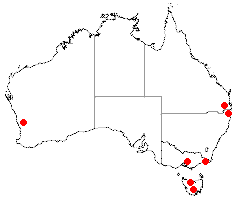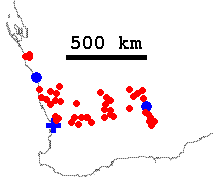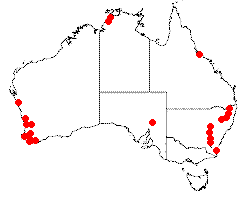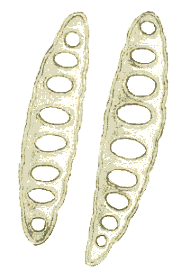|
Lichen biogeography
Lichens in Australia
The first published report of an Australian lichen appeared in 1806 and since then numerous species have been reported for Australia. Currently over 3000 species are said to occur in Australia and a little over a third are not known elsewhere. Amongst those 3000 plus there are still undoubtedly some invalid records. Such invalid records can arise from a variety of causes and the following paragraph will give some examples.
Specimens collected in Australia have been the basis for the descriptions of many species. At times what has later been shown to be the one species has been described as new several times under a variety of names. Here is an example. In 1876 James Stirton of Glasgow described the new species Graphis mucronata (photo below). In 1882 Jean Müller of Geneva described four new species (Phaeographis australiensis, Phaeographis cinerascens, Phaeographis inscripta, Phaeographis subcompulsa) and in the same year Charles Knight of New Zealand described the new species Graphis aulacothecia. All these species were based on material collected in New South Wales. Recent study has shown that all these species are identical and Stirton's name is the one used for it. The species Letrouitia subvulpina, originally described from Cuba, was once thought to occur in Queensland. This was based on the assumed equivalence of that species with Letrouitia sayeri, the original description of which was based on material collected from Queensland and was published after that of Letrouitia subvulpina. Chemical and microscopic analysis has shown the two are best considered as separate, though superficially similar, species. The species Trypethelium exiguellum was described in 1899, based on a specimen collected on Thursday Island in Queensland, and for a century was not recorded from anywhere else. In 1992 this seemingly Australian endemic lichen was shown to be a non-lichenized fungus. Lepraria incana, widespread in the world, had been thought to occur in Tasmania, Victoria and Western Australia but a recent study found no evidence of the species in Australia. Australian specimens named as Lepraria incana were found to be misidentifications of Lepraria lobificans or Lepraria yunnaniana. Lecanora subpiniperda and Lecanora subpurpurea were originally described in 1882 and 1899 respectively, based on material collected in New South Wales and Queensland, respectively. The original species descriptions were very brief and the original (or type) specimens can no longer be found. It is therefore impossible to re-examine the type specimens with modern methods to see if or how those two species differ from others in the genus. Those two Lecanora species are therefore doubtful species![]() .
.
The previous paragraph gave examples of some of the erroneous Australian species records that have been detected and removed. It is easy to see that erroneous records have biogeographic implications. There are still various lichen groups in need of critical study in Australia and future studies of such groups will undoubtedly reveal more dubious species records. Nevertheless, even allowing for such undetected errors, there are still a great many species well studied and validly recorded for Australia, so making some biogeographical analysis possible. With such a wide range of lichens found in Australia it's not surprising that they are geographically distributed in a variety of ways. The DISTRIBUTION PATTERNS page gave examples of distribution patterns, a number of which included Australia. The following two pages give some more biogeographical information about the lichens found in Australia:
AUSTRALIA AND ELSEWHERE – This page gives some examples of lichens found in Australia and other parts of the world.
ENDEMIC TO AUSTRALIA – Deals with lichens known only from Australia.
The remainder of this page will be devoted to a couple of examples, the first involving a single species and the second the summary of a single field trip. The first shows that it can take a considerable time to build up a good picture of a particular species' distribution while the second shows that Australia still offers great scope for lichen exploration, even in non-remote areas. Both show that there are still likely to be many changes in ideas about the biogeography of Australian lichens.
Buellia levieri
Buellia levieri is a good example of a species that, for many years, appears to be confined to a very small area of Australia but is then shown to be far more widespread. This species was described in 1911 by Antonio Jatta, of Italy, based on material collected near Geeveston in Tasmania by William Weymouth. There is no record of habitat information with the specimen, but it seems likely that it was collected in a cool temperate rainforest. A second collection, from cool temperate rainforest in a different area, was made in 1983 by the Tasmanian lichenologist Gintaras Kantvilas. The authors of a paper published in 1994 noted that the species was then still known only from those two collections and wrote:
That only two collections of this species are known, despite extensive recent collecting activity in Tasmania, particularly in wet forests, suggests it is extremely rare.
 In 2007 it was reported from Western Australia and by the end of 2009 it had been reported also from New South Wales, Queensland, Victoria and distant South America. Despite now being known from widespread parts of Australia it is still rare and known from very few locations as you can see from the accompanying map. However the currently known distribution suggests that the species is likely to be found at other places as well. Moreover, it appears to tolerate a variety of habitats since it was collected in Western Australian from a dead Acacia in remnant Acacia-Eucalypt woodland along a seasonal creek, quite different to the cool temperate rainforest of Tasmania
In 2007 it was reported from Western Australia and by the end of 2009 it had been reported also from New South Wales, Queensland, Victoria and distant South America. Despite now being known from widespread parts of Australia it is still rare and known from very few locations as you can see from the accompanying map. However the currently known distribution suggests that the species is likely to be found at other places as well. Moreover, it appears to tolerate a variety of habitats since it was collected in Western Australian from a dead Acacia in remnant Acacia-Eucalypt woodland along a seasonal creek, quite different to the cool temperate rainforest of Tasmania![]() .
.
A western fortnight
There are still many areas of Australia that are largely unexplored from a lichenological perspective. There are diverse habitats (and micro-habitats) in the many areas that are accessible only by rough roads, especially when you look at the large part of Australia that is more than say a hundred or so kilometres from the nearest coast. However, it is not necessary to go to remote areas to make interesting finds.
 During April-May of 2004 the Australian lichenologist Jack Elix and two fellow cryptogamists spent a fortnight collecting lichens, bryophytes and fungi in south-west Western Australia, predominantly in non-coastal areas, and the red dots on the accompanying map show the collecting sites. The blue cross to the lower left indicates Perth. The blue dots indicate Geraldton (north of Perth) and Kalgoorlie (to the east). The area covered is not remote from major towns or cities, most of the sites were accessible by all-weather roads and the fortnight produced many interesting collections. With regard to the lichens many collections were of species already known to occur in Western Australia but of these a good proportion were collected from areas where they had not been recorded previously. There were also specimens of lichens already known from other parts of Australia (and perhaps overseas as well) but not yet from Western Australia. The following is a list of those species as well as the other places where the species had been found, first the Australian states or territories and then, after a dash, any overseas countries or regions. Where a species is known only from Australia I give, in brackets, the year in which the first description of the species was published.
During April-May of 2004 the Australian lichenologist Jack Elix and two fellow cryptogamists spent a fortnight collecting lichens, bryophytes and fungi in south-west Western Australia, predominantly in non-coastal areas, and the red dots on the accompanying map show the collecting sites. The blue cross to the lower left indicates Perth. The blue dots indicate Geraldton (north of Perth) and Kalgoorlie (to the east). The area covered is not remote from major towns or cities, most of the sites were accessible by all-weather roads and the fortnight produced many interesting collections. With regard to the lichens many collections were of species already known to occur in Western Australia but of these a good proportion were collected from areas where they had not been recorded previously. There were also specimens of lichens already known from other parts of Australia (and perhaps overseas as well) but not yet from Western Australia. The following is a list of those species as well as the other places where the species had been found, first the Australian states or territories and then, after a dash, any overseas countries or regions. Where a species is known only from Australia I give, in brackets, the year in which the first description of the species was published.
Amandinea extenuata Buellia aethalea Buellia bahiana Buellia curatellae Buellia demutans Buellia pseudotetrapla Buellia substellulans Buellia tetrapla Canoparmelia norstictica Cladonia enantia Collema novozelandicum Diploschistes aeneus Hypocenomyce foveata Lecanora galactinizia Lecanora symmicta Lecidea plana Lecidella carpathica Melanelia piliferella |
Opegrapha herbarum Parmotrema grayanum Pertusaria rigida Protoparmelia pulchra Ramboldia arandensis Ramboldia brunneocarpa Trapelia lilacea Trapeliopsis flexuosa Xanthoparmelia barthlottii Xanthoparmelia dubitata Xanthoparmelia fracticollisi Xanthoparmelia mayrhoferi Xanthoparmelia nebulosa Xanthoparmelia neodelisei Xanthoparmelia paratasmanica Xanthoparmelia remanella Xanthoparmelia segregata Xanthoparmelia streimannii Xanthoparmelia subcrustulosa Xanthoparmelia subloxodella |
The fieldwork also yielded specimens of two species, previously known from outside Australia, but not yet found in Australia - Diploschistes conceptionis (known from Chile and Uruguay) and Xanthoparmelia applicata (known from South Africa)![]() .
.
Finally, the following new species (and one new subspecies) have been described, based on specimens collected during that fortnight: Buellia psoromica, Diploschistes elixii, Buellia xanthonica, Hypocenomyce isidiosa, Maronina hesperia, Parmeliopsis chlorolecanorica ![]() , Pertusaria subarida, Thysanothecium hookeri subsp. xanthonicum and Xanthoparmelia baeomycesica.
, Pertusaria subarida, Thysanothecium hookeri subsp. xanthonicum and Xanthoparmelia baeomycesica.
 The distributional information given for any species listed above reflects the state of knowledge on the eve of the publication of that species' discovery in Western Australia. For example, the Western Australian find of Buellia substellulans was published in 2006 and until then the species had been known only from Queensland and New South Wales, and in both those states since 1886. It took 120 years to expand its known distribution - and then considerably. The paper that published the Western Australian find also reported collections from the ACT, the Northern Territory and Tasmania, so giving this species a wide, though still patchy, distribution in Australia, as shown in the accompanying map. There are other species listed above which are also now known from other places but I haven't given the currently known distribution for each. The aim of the above is simply to show that a fortnight's concentrated searching in a rather small, non-remote area of Australia is capable of yielding an impressive addition to knowledge of the country's lichens. Such discoveries are not confined to Western Australia and, since 2004, comparable results have resulted from concentrated field work over similar periods in various other non-remote areas of Australia.
The distributional information given for any species listed above reflects the state of knowledge on the eve of the publication of that species' discovery in Western Australia. For example, the Western Australian find of Buellia substellulans was published in 2006 and until then the species had been known only from Queensland and New South Wales, and in both those states since 1886. It took 120 years to expand its known distribution - and then considerably. The paper that published the Western Australian find also reported collections from the ACT, the Northern Territory and Tasmania, so giving this species a wide, though still patchy, distribution in Australia, as shown in the accompanying map. There are other species listed above which are also now known from other places but I haven't given the currently known distribution for each. The aim of the above is simply to show that a fortnight's concentrated searching in a rather small, non-remote area of Australia is capable of yielding an impressive addition to knowledge of the country's lichens. Such discoveries are not confined to Western Australia and, since 2004, comparable results have resulted from concentrated field work over similar periods in various other non-remote areas of Australia.
Lichen biogeography pages on this website Distribution patterns |
![An Australian Government Initiative [logo]](/images/austgovt_brown_90px.gif)


